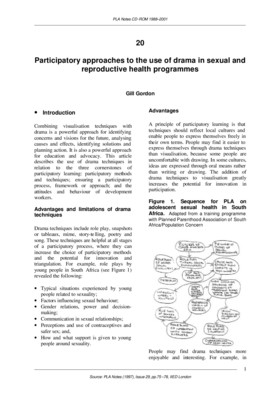PLA Notes CD-ROM 1988-2001 20 Participatory approaches to the use of drama in sexual and reproductive health programmes

Document begins: PLA Notes CD-ROM 19882001 20 Participatory approaches to the use of drama in sexual and reproductive health programmes Gill Gordon Introduction Advantages Combining visualisation techniques with A principle of participatory learning is that drama is a powerful approach for identifying techniques should reflect local cultures and concerns and visions for the future, analysing enable people to express themselves freely in causes and effects, identifying solutions and their own terms. People may find it easier to planning action. It is also a powerful approach express themselves through drama techniques for education and advocacy. This article than visualisation, because some people are describes the use of drama techniques in uncomfortable with drawing. In some cultures, relation to the three cornerstones of ideas are expressed through oral means rather participatory learning: participatory methods than writing or drawing. The addition of and techniques; ensuring a participatory drama techniques to visualisation greatly process, framework or approach; and the increases the potential for innovation in attitudes and behaviour of development participation. workers. Figure 1. Sequence for PLA on Advantages and limitations of drama adolescent sexual health in South techniques Africa. Adapted from a training programme with Planned Parenthood Association of South Africa/Population Concern Drama ...
Cite this publication
Available at https://www.iied.org/g01713